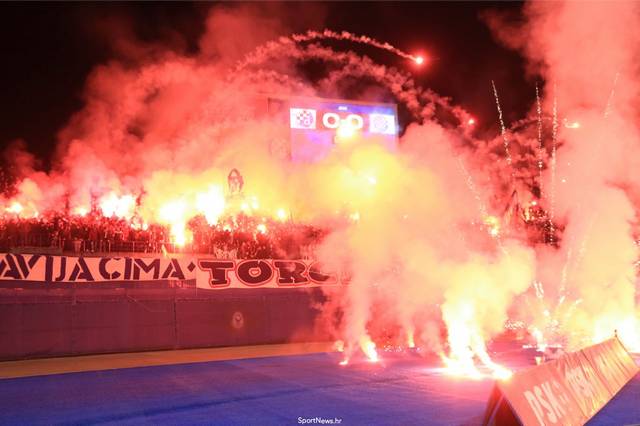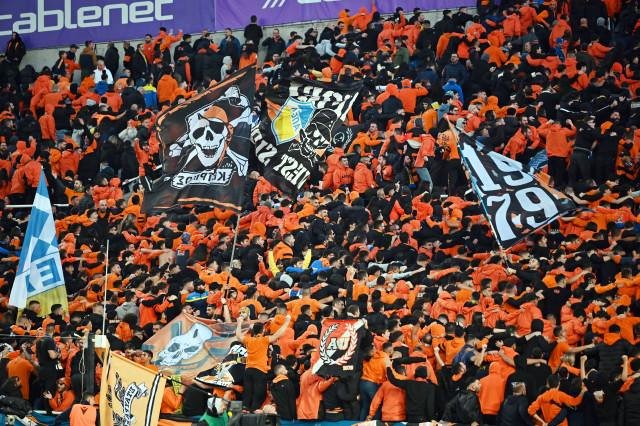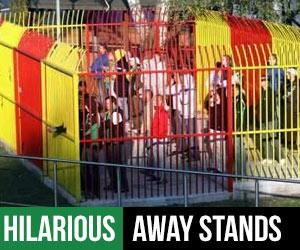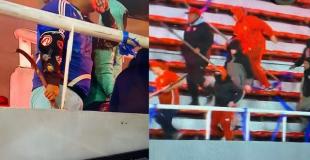Want to buy pyrotechnics? Visit pyro.ultras-tifo.net

Welcome to the electrifying realm of football ultras, where passion knows no bounds and loyalty runs deeper than the veins of the sport itself. In this article, we embark on a journey to unravel the enigmatic world of football ultras – a subculture within the global footballing community that is as captivating as it is often misunderstood. These devoted fans, known as ultras, are the heartbeat of their clubs, infusing stadiums with unparalleled energy and devotion. Here, we delve into the depths of their culture, exploring the unique rituals, chants, and attire that set ultras apart. We'll witness their unwavering loyalty to their beloved teams, which transcends mere fandom and approaches a sacred commitment. Yet, as we navigate this passionate landscape, we cannot ignore the challenges and controversies that have shrouded ultras, from incidents of hooliganism and fan violence to their involvement in politics. Join us as we navigate this exhilarating world, seeking to understand the fervor, camaraderie, and complexities that define football ultras.
The History of Football Ultras
The roots of football ultras can be traced back to their humble beginnings, emerging as a passionate and fervent response to the sport in its early days. While the exact inception is shrouded in the mists of time, ultras culture began to take shape in the mid-20th century across European football clubs. One of the pivotal moments in this evolution was the formation of the "Gruppo Autonomo" by Napoli ultras in the 1960s. This marked a departure from traditional spectatorship, as these ultras began to organize themselves into tightly-knit groups, characterized by their chants, flags, and banners.
As the decades rolled on, ultras culture continued to flourish and expand, with each club's group developing its unique identity, customs, and rivalries. The 1980s, in particular, witnessed the zenith of ultras culture as these passionate supporters became an integral part of the footballing spectacle, shaping the atmosphere in stadiums and elevating the sport to new heights. The evolution of ultras has seen the spread of their influence from Europe to other continents, adopting local cultural elements while maintaining the core of ultras ethos.
Understanding the historical underpinnings of football ultras is essential to appreciating the rich tapestry of culture, loyalty, and challenges that define their world today. Below is a thematic table illustrating some of the pivotal ultra groups, their inception years, and notable characteristics, highlighting the diversity and reach of ultra culture globally.
| Ultra Group | Club | Country | Inception Year | Notable Characteristics |
|---|---|---|---|---|
| Gruppo Autonomo | Napoli | Italy | 1960s | One of the earliest groups, known for their autonomy and intense loyalty. |
| Gate 13 | Panathinaikos | Greece | 1966 | Renowned for vibrant displays and political activism. |
| Commando Ultrà Curva Sud | Milan | Italy | 1968 | Known for elaborate choreographies and a fierce rivalry with Inter. |
| The Yellow Wall | Borussia Dortmund | Germany | 1970s | Famous for creating one of the most intimidating atmospheres in football. |
This table represents just a snapshot of the rich and diverse world of football ultras, each group with its unique inception story and set of traditions that contribute to the global tapestry of football fandom. From their inception to their current status, these groups reflect the evolution of ultra culture and its impact on the world of football.
The Culture of Football Ultras
The culture of football ultras is a mesmerizing tapestry of traditions and fervor, painting a vivid picture of their unwavering dedication to their clubs. One cannot delve into ultras culture without encountering their distinctive dress code, a visual testament to their loyalty. Ultras often don attire that reflects their team's colors and symbols, proudly sporting scarves, banners, and customized jerseys emblazoned with club insignias. This sartorial commitment is not mere fashion but a statement of allegiance that symbolizes their unbreakable bond with their team.
Yet, the culture of ultras extends far beyond clothing. It finds expression in the choreographies that grace the stands, a breathtaking display of coordinated movements and colorful tifos that transform stadiums into living canvases. These choreographies are meticulously planned and executed, serving as both a source of inspiration for their team and a visual manifestation of ultras' passion for the beautiful game.
Equally essential to the culture of ultras are their chants, which echo through the stadiums with infectious energy. These chants are more than just songs they are anthems of devotion, uniting thousands of voices in a harmonious chorus that reverberates long after the final whistle. In the midst of these chants, ultras find not only camaraderie but also a profound sense of identity and belonging. Their groups become like families, bound together by their shared passion for their club. It is this sense of belonging that fuels the unyielding loyalty of ultras, turning them into a force that can propel their team to victory, even in the face of adversity.
Loyalty Beyond Measure
When it comes to loyalty, football ultras stand as exemplars of unwavering devotion to their clubs. Their commitment transcends the boundaries of traditional fandom, reaching levels that are truly exceptional. Ultras are often the first to arrive at the stadium and the last to leave, their presence a constant source of inspiration for their players. Rain or shine, victory or defeat, ultras remain steadfast, displaying a loyalty that knows no bounds.
To grasp the depth of ultras' loyalty, one need only look at the extraordinary lengths to which they are willing to go in support of their team. These dedicated fans travel thousands of miles to attend away matches, creating a sea of their team's colors in rival territory. They endure extreme weather conditions, financial strains, and the rigors of travel, all in the name of supporting their beloved club.
Extreme displays of loyalty are not limited to matchdays alone. Ultras often engage in community outreach, charitable endeavors, and social causes aligned with the values of their club. This dedication extends far beyond the confines of the football pitch, showcasing the enduring impact of ultras on the communities they are a part of.
The Rituals and Traditions That Ignite Ultras Culture
Stepping into the passionate world of football ultras unveils a tapestry of rituals and traditions that set them apart as a remarkable subculture within the sporting universe. These customs, as diverse as the fans themselves, are far more than just routines—they are the beating heart of ultras culture. One such tradition is the pre-match congregation at local pubs, clubs, or designated meeting spots, where ultras convene to share stories, songs, and chants. This time-honored ritual not only fortifies their camaraderie but also serves as a spirited prelude to the impending clash on the pitch.
Recently, some ultras groups have incorporated unique experiences into their pre-match rituals, such as gathering at casinos or themed venues like svenska casinon online, reflecting the dynamic energy of the ultras themselves. These gatherings are not just about enjoying food and beverages but are also a testament to the ultras' creativity and adaptability, infusing traditional pre-match activities with innovative elements that further enhance their sense of unity and excitement.
Yet, it's the visual extravagance that often takes center stage. Massive banners, intricate tifos, and choreographed displays are all part of the ultras' repertoire. These creations are not mere eye candy; they are powerful symbols of unity and devotion. When unfurled within the stadium, they transform the arena into a breathtaking canvas of support, binding ultras together in their unwavering dedication to the team. These visual spectacles transcend art; they are a collective statement of identity and passion that pulses through the stands.
But it's the chants and songs that form the living, breathing pulse of ultras culture. Each ultras group boasts its own unique repertoire, and these auditory expressions are more than just noise—they are a language, a call to arms that resonates through the stadium. When thousands of voices unite in rhythmic harmony, it creates an electric atmosphere that defines the essence of ultras support. It's an experience that leaves an indelible mark on players, fans, and the sport itself, forging an unforgettable connection that transcends the boundaries of a typical fan-club relationship.
Challenges and Controversies
As we delve deeper into the passionate world of football ultras, it becomes evident that their fervor often intersects with the complex realm of politics, giving rise to both admiration and apprehension. This intersection can manifest in various ways, with ultras groups aligning themselves with political ideologies, causes, or movements. While some view this as a means to amplify their message and influence, it can also introduce a volatile dimension to the footballing landscape, potentially polarizing fans and sparking controversy.
However, it's essential to acknowledge that the challenges and controversies surrounding ultras extend beyond their political affiliations. Incidents of hooliganism and fan violence have cast a shadow over the ultras community, tarnishing their reputation and raising concerns about the safety of matches. Clubs and authorities, cognizant of these issues, have implemented a range of measures to address these challenges. Enhanced security measures, stringent regulations, and sanctions against unruly behavior are among the strategies employed to mitigate the negative aspects associated with ultras culture while preserving the passionate essence that makes it so unique.
The interplay between ultras culture, politics, and the efforts to ensure safety and order in football stadiums is a multifaceted and evolving narrative. As we explore these complexities, it becomes clear that the passionate world of football ultras is not without its challenges and controversies, and finding a delicate balance between preserving the culture and addressing these issues remains an ongoing endeavor.
The Future of Football Ultras
As we peer into the crystal ball of football ultras culture, it's clear that this passionate world is on an evolutionary path, one that holds both promise and uncertainty. The dynamics of ultras culture are shaped by an ever-changing societal and footballing landscape. While challenges such as hooliganism and political entanglements persist, there is also a growing awareness among ultras of the need for responsible fandom and a commitment to positive change.
The future may see ultras continuing to adapt and modernize their methods of support, harnessing the power of technology and social media to amplify their messages and organize collective actions. These tools can provide a platform for ultras to engage with a global audience, further strengthening their bonds of solidarity and emphasizing the positive aspects of their culture.
Additionally, there is potential for ultras to play a pivotal role in fostering a more inclusive and diverse footballing environment, one that welcomes fans from all walks of life. By championing responsible behavior and embracing diversity within their ranks, ultras can reshape their image and contribute to a more harmonious coexistence with clubs, authorities, and fellow fans.
The future of football ultras culture is a complex tapestry that weaves together the threads of tradition, innovation, passion, and responsibility. It remains an open canvas, waiting for the ultras themselves to paint the picture of what their culture will look like in the years to come.
Final Thoughts
In concluding our journey through the passionate world of football ultras, we find ourselves amidst a culture that defies simple characterization. It is a culture steeped in tradition, loyalty, and fervor that transcend the boundaries of conventional fandom. The rituals, chants, and displays of ultras paint a vivid tapestry of devotion that transforms stadiums into cauldrons of emotion, leaving an indelible mark on the beautiful game.
Yet, as we've uncovered, this culture is not without its challenges and controversies. The intersection of ultras with politics, incidents of hooliganism, and concerns about fan violence have cast a shadow over their unwavering support. Clubs and authorities have responded with measures to maintain order and safety while preserving the essence of ultras culture.
Our exploration has revealed that football ultras are a complex and multifaceted community, defined by their passionate devotion and the intricate challenges they navigate. As we reflect on this enigmatic world, it is vital to acknowledge the duality that exists within ultras culture—the celebration of a profound love for the game and the need to address the issues that have marred their image. The future of football ultras remains an open canvas, where tradition, innovation, responsibility, and passion converge, awaiting the next chapter in this captivating story.

FAQ
Who are football ultras, and what sets them apart from regular fans?
Football ultras are a passionate subset of fans known for their unwavering loyalty and vibrant displays of support for their clubs. What sets them apart is their distinct culture, which includes choreographed chants, massive banners, and a deep sense of identity and belonging within their fan groups.
How did the culture of football ultras originate?
The culture of football ultras traces its roots back to the mid-20th century in Europe. It evolved as fans began organizing themselves into tight-knit groups, embracing unique traditions and rituals to express their devotion to their teams. Over time, ultras culture has become a powerful force in the world of football fandom.
What are some common rituals and traditions of football ultras?
Football ultras engage in a range of rituals and traditions, including pre-match gatherings at local pubs, choreographed displays of banners and tifos, and the chanting of unique songs during matches. These customs create a sense of unity and amplify the atmosphere in stadiums.
How loyal are ultras to their clubs, and what makes their loyalty unique?
Ultras are renowned for their unwavering loyalty to their clubs. They attend matches religiously, often traveling long distances to support their teams, and they embrace a profound sense of identity and belonging within their fan groups. Their loyalty goes beyond typical fandom, making them a cornerstone of their club's support.
What challenges and controversies surround football ultras culture?
Ultras culture can intersect with politics, which can lead to both admiration and controversy. Additionally, incidents of hooliganism and fan violence have raised concerns. Clubs and authorities have implemented measures to address these issues while preserving the passionate essence of ultras culture.
How can football ultras contribute positively to the sport?
Ultras have the potential to contribute positively by embracing responsible fandom, promoting inclusivity, and championing diversity within their ranks. They can also use their passionate influence to support charitable causes and create a vibrant and welcoming atmosphere in stadiums.
What does the future hold for football ultras culture?
The future of ultras culture remains dynamic, with opportunities for both tradition and innovation. Ultras may continue to adapt, emphasizing responsible behavior and community engagement, while preserving their passionate devotion to their clubs and the sport they love.











